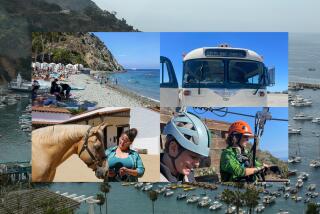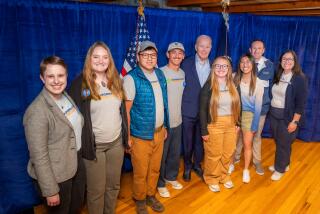WET & WILD : Group Gives Kelp a Helping Hand
Santa Catalina will soon be surrounded by 170-pound thermometers.
That’s the plan of Steve Benavides, president of a group called Catalina Conservancy Divers. “We’re setting out to gather data that nobody has ever gathered before,” says Benavides, 43, a tax attorney in Irvine. “You can’t conserve what you can’t control, you can’t control what you don’t understand, and you can’t understand what you haven’t studied.”
In this case, the objects of study are the island’s kelp forests. Scientists hope that by observing the correlation between their growth and the temperature of the surrounding water, they’ll eventually be able to propose environmental regulations designed to restore the kelp, which has dwindled dramatically in recent years, thus protecting a marine environment capable of supporting large amounts of underwater life.
Though some scientists believe that higher water temperatures have a detrimental effect on kelp growth, Benavides said, “there’s no agreement in the scientific community about the effects of temperature” which, around Catalina, ranges from the low 50s in winter to about 71 degrees in August, September and October. “We know more about the back side of the moon than we know about the ocean,” Benavides said. “Rather than coming out with positions that don’t have any scientific basis, we’ll be able to make recommendations with good data to back them up.”
While conservationists cannot control the temperature of the ocean, researchers acknowledge, their ability to legislate wise policies may be enhanced by an understanding of how much environmental deterioration is due to such natural conditions as fluctuating temperatures and how much is due to more controllable human factors such as pollution.
The effort began about two years ago, shortly after the formation of Catalina Conservancy Divers, a nonprofit group of volunteer scuba divers from throughout Southern California committed to the restoration and protection of Catalina’s marine environment. The organization’s other projects have included the planting of about 8,000 juvenile abalone, and various underwater cleanups.
But surrounding the island with a ring of working temperature-taking devices would take muscle and money. The muscle was readily available among the club’s 180 members, all of whom love diving in the clear waters of this scuba mecca. The money, however, was another matter; about $20,000 of it had to be raised through corporate grants, membership fees and individual contributions.
To date, according to Benavides, 10 instruments called thermographs have been placed at strategic points around the island. Each is worth about $1,000 and consists of a precision thermometer the size of a transistor radio sealed in a 10-inch plastic housing protected by a three-foot metal tube. During the next several months, he said, the divers expect to place 10 more thermographs, completing a virtual ring around the island.
Equipped with microprocessors, the instruments measure the temperature of the surrounding water at regular intervals, storing the information on tiny computer chips. Eventually, Benavides said, the divers--working in teams of four--will begin returning to the sites several times a year to retrieve the temperature data. They will also make periodic dives to measure the growth of the surrounding kelp beds and survey the marine life in specific test areas.
The divers say they will share their findings with researchers at the island’s Wrigley Marine Science Center, who will use it to help determine what factors are contributing most to inhibited kelp growth and decreased marine life observed in recent years.
“I think the project is really innovative,” said Flo McAlary, a marine biologist at the center who is working with the volunteer divers. “Right now there isn’t a lot of temperature information available. These thermal pictures will give us a fine-scale look at what the kelp forest environment is; there aren’t a lot of volunteer groups that will carry conservation to this point.”
The divers say they intend to continue the project for up to 10 years, giving researchers a complete set of data through at least one season of El Nino, the warm current that periodically flows north from Mexico wreaking havoc on Southern California’s marine environment.
“I applaud them,” McAlary said. “This is some of the best marine wilderness in the whole world; it is part of our human heritage on the planet, and I think that it’s a better alternative than an aquarium.”
Local divers wishing to participate should call (310) 510-1421.
More to Read
Sign up for Essential California
The most important California stories and recommendations in your inbox every morning.
You may occasionally receive promotional content from the Los Angeles Times.










